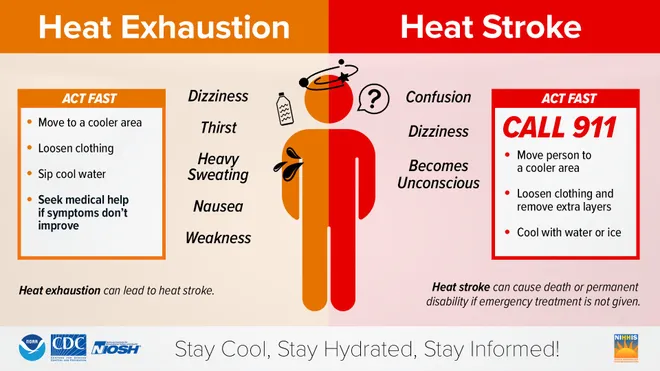How long does heat exhaustion last? What to know about the heat-related illness.
When you're enjoying a bright, hot and sunny day, the last thing you want to think about is getting sick. We tend to think we can only get sick on cold days. But that's not true.
There are many illnesses that occur outside of the winter months and some are life-threatening. In fact, several of these conditions can be triggered by bright, sunny days.
Heat-related illnesses can range in severity and each should be taken seriously. Heat exhaustion can lead to further complications if not treated properly. Here is what you need to know about heat exhaustion, including its symptoms and how long it lasts.
What is heat exhaustion?
Heat exhaustion is one of several heat-related illnesses. According to the Center for Disease Control and Prevention, heat-related illnesses include:
- Heat cramps
- Heat rash
- Heatstroke
- Rhabdomyolysis
- Heat syncope
All of these conditions can occur when your body overheats. This can be caused by exposure to hot temperatures, especially if it is humid or you are engaging in physical activity, according to the Mayo Clinic.
Your body's temperature is impacted by its environment. Your's body heat in relation to the environment's temperature is called "core temperature," according to the Mayo Clinic. The human body tends to remain at a core temperature of 98.6 degrees Fahrenheit.
Your body regulates temperature by sweating. When it is very hot outside, you are likely to sweat more since your body is trying to cool down. But if you are sweating excessively, this is not effective for maintaining homeostasis.
When you sweat, you lose fluids containing water, nutrients and salts that help you function properly. If you are not sufficiently replacing those lost fluids, you may experience a series of conditions, including dehydration or heat exhaustion.
Anyone can experience heat exhaustion. However, it can be impacted by other factors, such as age, alcohol use, medications or health conditions.
Older people and children are at higher risk of heat exhaustion since they are more likely to become dehydrated and often cannot regulate body temperature efficiently.
If you are drinking large quantities of alcohol, you also have a higher chance of heat exhaustion. When you are drinking, you can become dehydrated, which can lead to heat exhaustion. Alcohol also makes body temperature regulation harder, according to the Cleveland Clinic.
Some medications may trigger heat exhaustion if they lead to excessive loss of fluids, such as diuretics. Pre-existing conditions that lead to fluid loss, such as diabetes causing frequent urination, increase the risk of heat exhaustion.
Heat exhaustion symptoms
According to the Mayo Clinic and Cleveland Clinic, heat exhaustion symptoms include:
- Dizziness, lightheadedness, feeling faint
- Headache
- Fever of 100 degrees Fahrenheit
- Fatigue
- Nausea
- Muscle cramps
- Excessive sweating
- Cool, clammy skin with goosebumps
- Swollen extremities (feet, hands, ankles)
- Rapid heartbeat

How long does heat exhaustion last?
If your symptoms worsen within an hour, you should seek medical attention. If not treated properly, heat exhaustion can lead to heatstroke, which is a life-threatening condition.
Recovering from heat exhaustion can take between 24 to 48 hours, according to Mount Sinai. If you are still not improving within that time, see a doctor.
Just Curious for more? We've got you covered
USA TODAY is exploring the questions you and others ask every day. From "Can dehydration cause fever?" to "Can you drink too much water?" to "What is heatstroke?", we're striving to find answers to the most common questions you ask every day. Head to our Just Curious section to see what else we can answer for you.
Disclaimer: The copyright of this article belongs to the original author. Reposting this article is solely for the purpose of information dissemination and does not constitute any investment advice. If there is any infringement, please contact us immediately. We will make corrections or deletions as necessary. Thank you.






